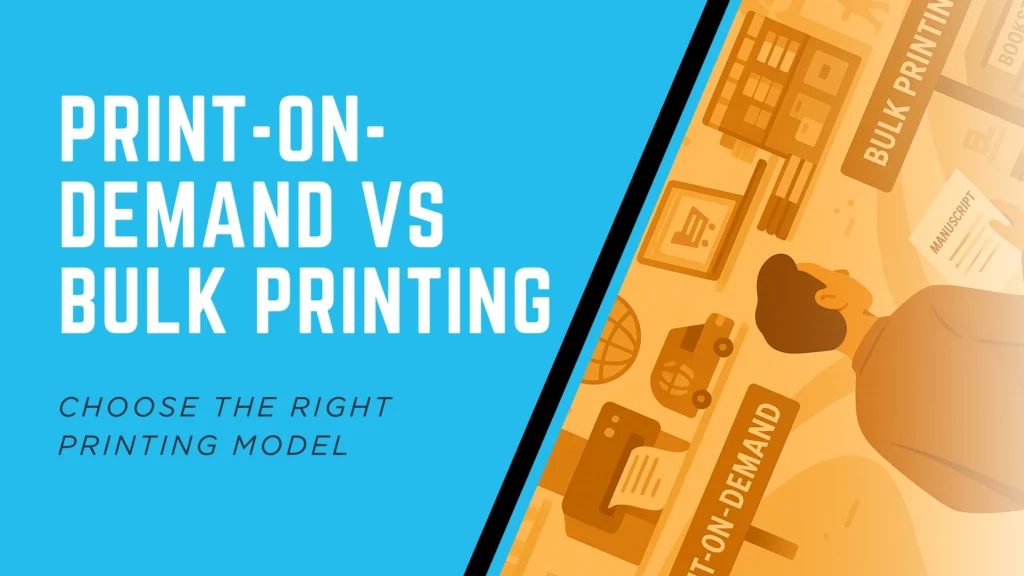As an author navigating the self-publishing landscape, one of the most significant decisions you’ll face involves how your physical books will be produced. The choice between print-on-demand (POD) and traditional bulk printing has major implications for your budget, distribution strategy, and overall publishing experience. This comprehensive guide will help you understand the pros and cons of each approach so you can make the best decision for your specific publishing needs.
Understanding the Two Printing Models
Print-on-demand technology represents the modern approach to book production. With POD, your book is digitally stored and printed only when a customer places an order. The process is fully automated—when a reader purchases your book, the POD service prints a single copy, ships it directly to the customer, and deposits your royalty. This approach has revolutionized self-publishing by removing traditional barriers to market entry.
POD services are typically integrated with major distribution channels like Amazon KDP, IngramSpark, and Barnes & Noble Press, making your book instantly available to global audiences. This accessibility allows indie authors to compete alongside traditional publishers in the same retail environments without massive upfront investments.
Bulk printing involves producing a predetermined number of books in a single production run. This traditional approach requires significant upfront investment but offers economies of scale—the per-unit cost decreases substantially as your print quantity increases. After printing, you’ll take possession of your inventory and handle storage, fulfillment, and shipping to retailers or individual customers.
While more hands-on, bulk printing gives you complete control over your book’s production quality. Many authors opt for this method when planning book launches, special editions, or when they have established sales channels that justify the upfront investment.
Evaluating Financial Considerations

Print-on-demand requires minimal upfront investment—typically just the cost of proper formatting and the purchase of a proof copy. You’ll pay no inventory costs, warehouse fees, or shipping supplies. This low-risk approach preserves your cash flow and eliminates the possibility of unsold inventory weighing down your publishing business.
The tradeoff comes in unit economics. POD books generally cost more per unit, with production costs ranging from $3-7 per book depending on specifications. This higher per-unit cost impacts your profit margin on each sale, though you’ll never pay for books that don’t sell.
Bulk printing demands a substantial initial investment. Depending on your book’s specifications and quantity, costs can range from several hundred to several thousand dollars. This approach ties up capital in physical inventory that may take months or years to sell through, creating potential cash flow challenges for new authors.
The financial advantage comes at scale. With bulk printing, the per-unit cost might drop to $1-3 per book with sufficient volume, dramatically increasing your profit margin on each sale. This makes bulk printing particularly attractive for authors with established audiences or those who sell primarily through direct channels where they retain the full retail price.
Financial planning is crucial regardless of which method you choose. Our (Book Formatting & Layout Design) service ensures your files meet professional standards for either printing method, optimizing both quality and cost efficiency.
Analyzing Quality and Customization Options
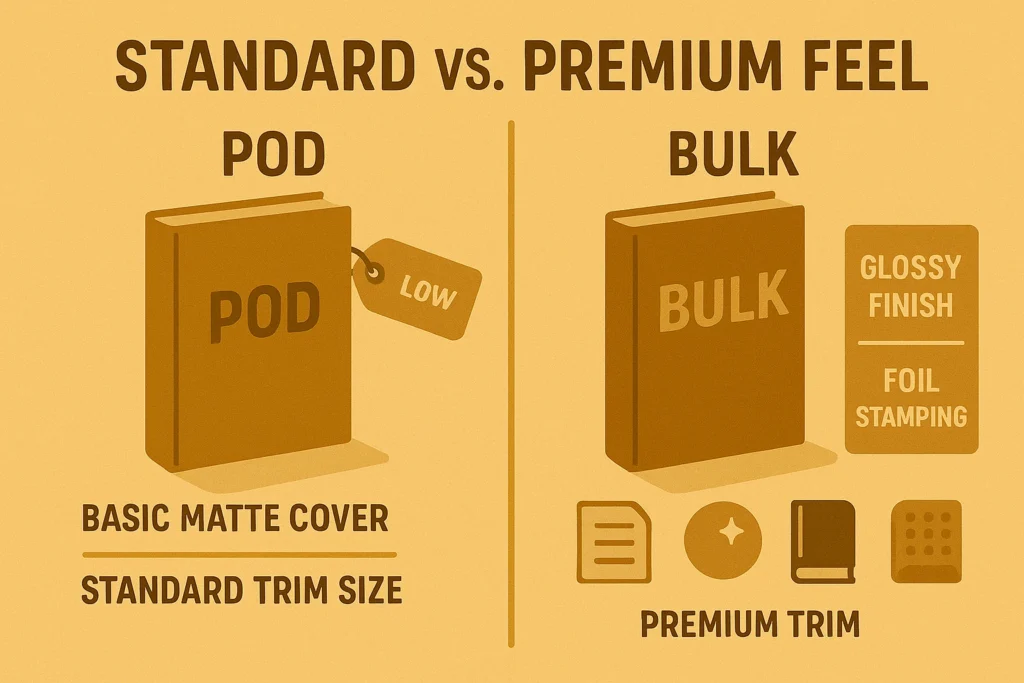
Print-on-demand technology continues to improve, but quality differences between POD and bulk printing remain. Current POD technology produces books that satisfy most reader expectations, with consistent color, clear text, and durable bindings. For standard fiction and non-fiction titles with simple interior designs, POD quality rarely becomes an issue for readers.
The limitations appear with specialty formats. POD services offer fewer paper options, limited cover finishes, and restricted trim sizes. Color printing, particularly for interior images, often shows noticeable quality differences compared to offset printing, making POD less ideal for photography books, art collections, or heavily illustrated works.
Bulk printing excels in quality and customization. The process allows for specialty papers, custom trim sizes, premium binding options, and finishes like embossing, debossing, foil stamping, or spot UV coating. Color reproduction tends to be more accurate and consistent across the print run, delivering a truly premium product for readers who appreciate physical book quality.
These customization options allow you to create a distinctive physical product that strengthens your author brand and justifies premium pricing. For special editions, collector’s versions, or books where physical presentation significantly impacts reader experience, bulk printing offers clear advantages.
Our professional (Cover Design) service creates covers optimized for your chosen printing method, ensuring maximum visual impact regardless of production approach.
Managing Inventory and Distribution
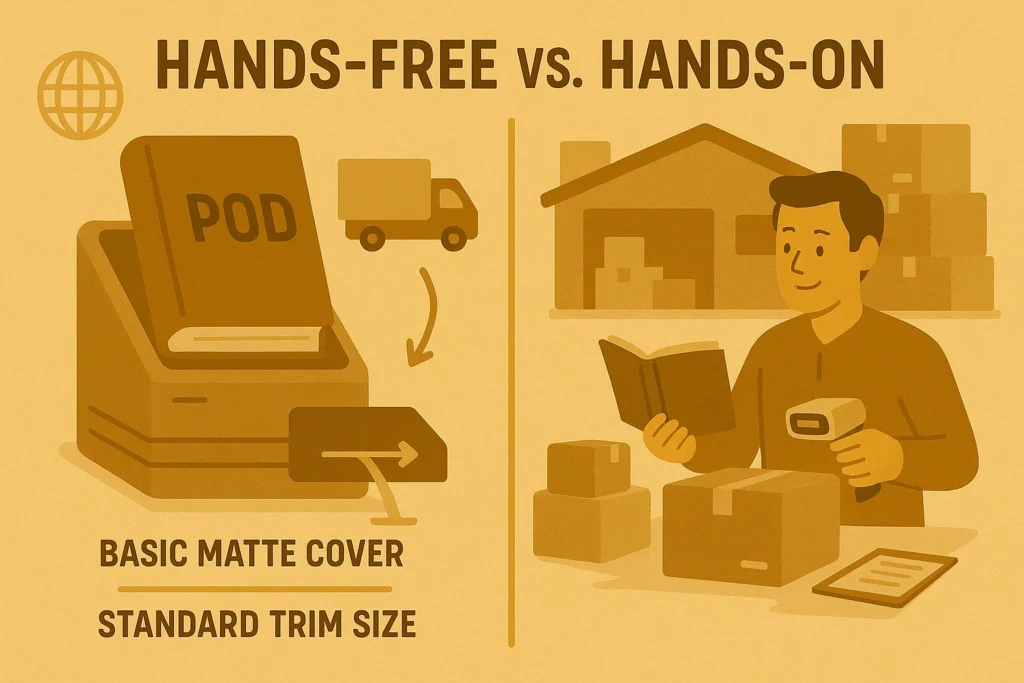
Print-on-demand eliminates inventory management concerns entirely. Your book exists digitally until purchased, removing worries about storage space, inventory tracking, damage, or obsolescence. The POD service handles all fulfillment logistics, including packing, shipping, and returns management. This hands-off approach frees your time and attention for writing and marketing rather than order fulfillment.
The distribution network for POD books extends globally through major retailers and online bookstores. Your book becomes available worldwide without additional effort or shipping complications. This expansive reach would be virtually impossible for most self-published authors to achieve independently.
Bulk printing makes you responsible for inventory management and distribution logistics. You’ll need adequate storage space, packaging materials, shipping supplies, and systems for tracking inventory and fulfilling orders. These responsibilities add complexity to your publishing operation and require time that could otherwise be devoted to creating or promoting your work.
However, having physical inventory creates unique distribution opportunities. You can sell directly to readers at events, conferences, or through your website, capturing the full retail price rather than just the royalty. You can approach local bookstores for consignment arrangements, participate in book fairs, or supply books for speaking engagements—options largely unavailable to POD-only authors.
Understanding your target audience’s buying preferences should influence your distribution strategy. Our (Publishing on Amazon KDP & Beyond) service includes distribution planning that optimizes your book’s availability through the most relevant channels for your specific readers.
Creating a Strategic Timeline
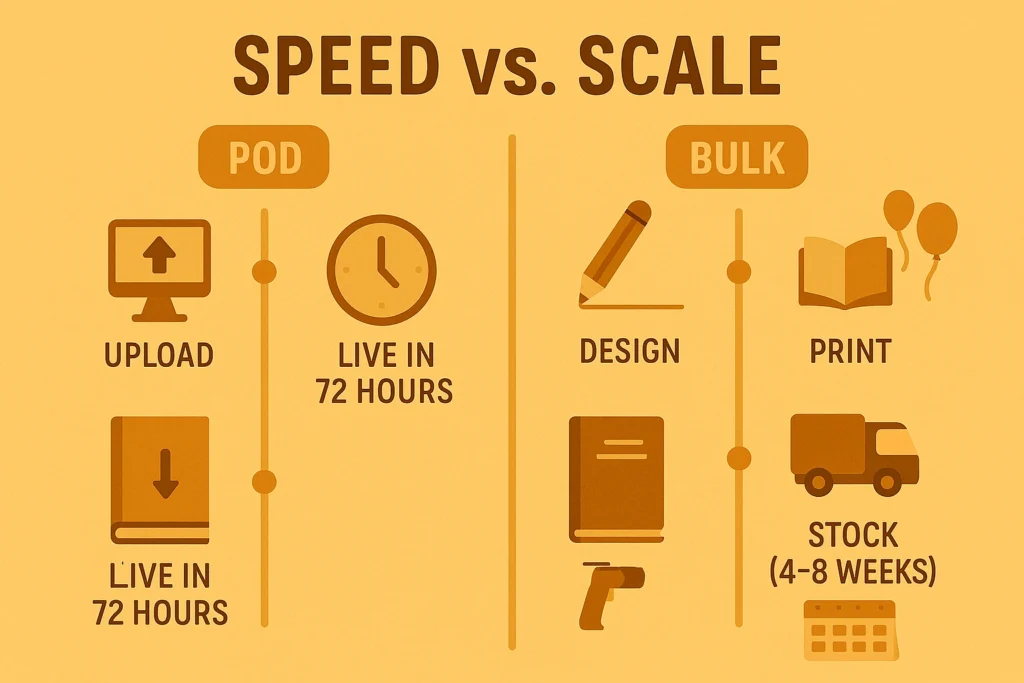
Print-on-demand offers virtually instantaneous availability once your files are approved. There’s no waiting for printing, shipping, or inventory processing. This speed provides remarkable flexibility, allowing you to make text revisions, update covers, or adjust pricing without wastage of existing inventory.
This accelerated timeline works particularly well for topical content, books tied to current events, or authors eager to build momentum quickly. POD also accommodates rapid publishing schedules for prolific authors who release multiple titles annually as part of their audience-building strategy.
Bulk printing requires extended planning horizons. The production process typically spans 4-12 weeks from file submission to delivery of your inventory. This timeline includes pre-press processing, printing, binding, quality control, shipping, and customs clearance for international printing.
This longer production cycle necessitates careful project management, especially for books with seasonal relevance or coordinated launch campaigns. You’ll need to build this extended timeline into your marketing plan, ensuring all promotional activities align with your inventory availability.
Our (Book Marketing) service can help create a promotional timeline that aligns with your production schedule, ensuring maximum marketing impact regardless of your chosen printing method.
Implementing Hybrid Approaches
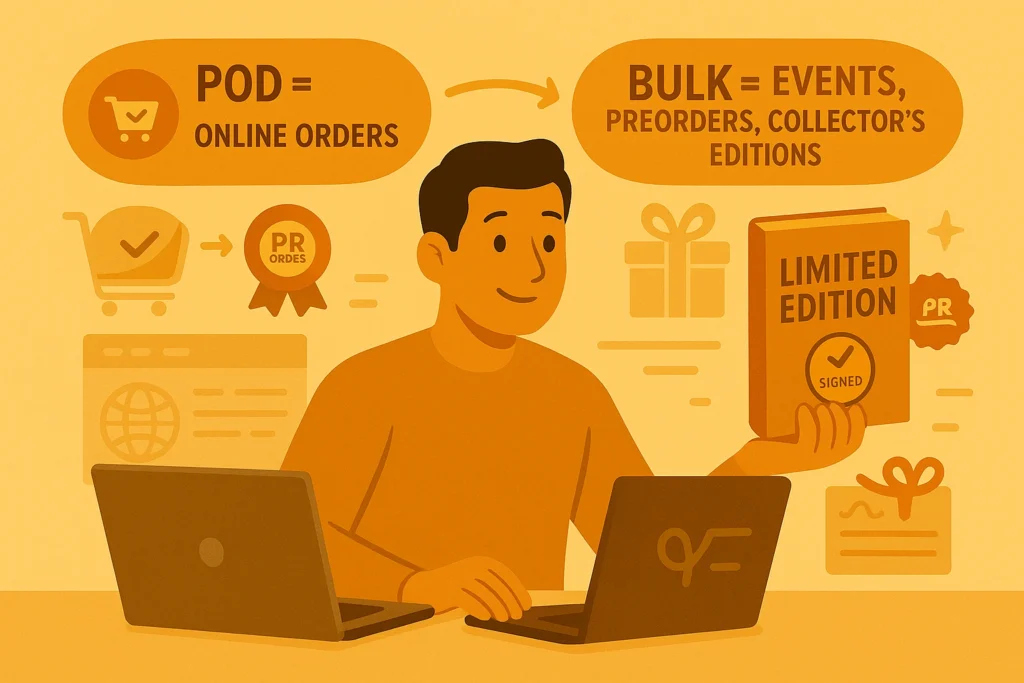
Many successful self-published authors implement hybrid approaches that capture advantages from both printing models.
The POD with Limited Offset approach starts with print-on-demand for general distribution while ordering a small bulk print run (100-300 copies) for direct sales, events, and special promotions. This strategy minimizes risk while providing inventory for higher-margin sales opportunities and reader interactions.
The Presale Validation Strategy uses POD initially while building audience interest through pre-orders and marketing. Once you’ve validated demand and gathered pre-orders, you can transition to a bulk print run with confidence in your minimum sales numbers, reducing the financial risk of offset printing.
The Tiered Quality Strategy offers a standard edition through POD for the mass market while creating a limited premium edition through bulk printing for collectors and superfans. This approach allows you to serve different market segments with appropriate product offerings and price points, maximizing revenue potential across your reader base.
Our (Editing & Proofreading) services ensure your manuscript is flawless regardless of which printing approach you choose, maintaining consistent quality across all editions of your work.
Conclusion: Making the Right Choice for Your Publishing Goals
Neither print-on-demand nor bulk printing is inherently superior—each serves different publishing scenarios effectively. Your decision should align with your specific circumstances, goals, and resources rather than following generic advice.
Print-on-demand offers the ideal entry point for new authors, those with limited budgets, or anyone prioritizing wide distribution with minimal logistics. The low upfront investment, global reach, and hands-off fulfillment create an accessible path to market that has democratized publishing.
Bulk printing makes sense for established authors with proven demand, those planning extensive in-person sales, or books requiring premium production quality. The improved unit economics and quality control can significantly enhance profitability and reader experience for those with the resources to manage the additional complexity.
Many successful authors evolve their printing strategy over time, starting with POD and transitioning to hybrid or bulk printing as their audience grows and sales channels develop. This progressive approach allows you to scale your publishing operation in alignment with your success rather than overcommitting resources prematurely.
The most important factor is making an informed decision based on clear understanding of the tradeoffs involved. By aligning your printing strategy with your specific goals, audience, and resources, you position your book for both creative and commercial success in the competitive self-publishing marketplace.
Ready to implement the right printing strategy for your book? Book a free consultation with our publishing team.


